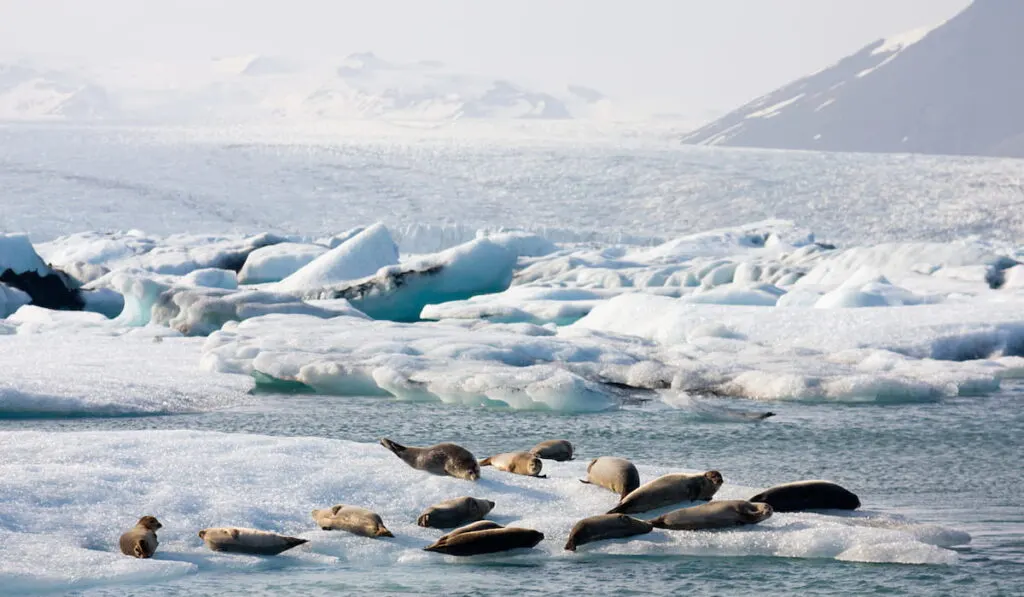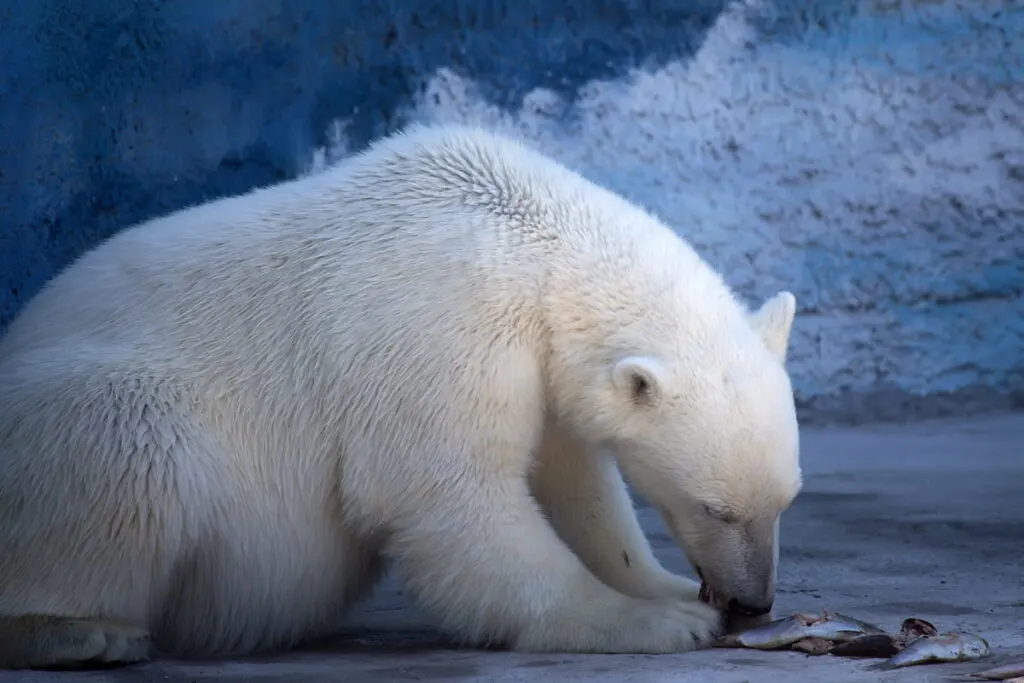Polar bears are such beautiful animals. Their milky white color and natural adaptation to the cold fascinates me. One of the things I was asked recently was whether or not polar bears eat penguins. Of course, it makes sense why many people would think this because they both live in snowy, icy regions.
Do polar bears eat penguins? Polar bears do not eat penguins. The polar bears and penguins live on opposite sides of the world; Polar Bears are found in the North Pole and the penguins are found in the South Pole. It is next to impossible for both animals to meet, which is the reason why penguins cannot be hunted by polar bears.

Table of Contents
What Do Polar Bears Eat?
Let’s talk about a polar bear’s eating habits. An adult male Polar Bear weighs around 900 lbs. The polar bear has a huge stomach which contributes 15-20% of his entire body weight.
This is the largest member of the bear family and, according to Sea World, they need to eat at least 4 pounds of fat each day to survive in the weather conditions that they live in.
Polar bears have a thick layer fat under their skin called “Blubber” which keeps their body warm in the icy regions. This layer of fat has to be maintained for survival.
The various methods that the polar bear uses to hunt his prey are still hunting, aquatic stalking, and stalking of birth lairs. It is mainly a carnivorous animal but can resort to eating vegetation, berries and human garbage during spring and early summer in absence of any prey.
They are natural predators and are extremely strong; you can say that they are the only species that will actively hunt humans for food.

Let’s have a look at what this carnivore’s diet looks like:
The Ringed Seal
As mentioned earlier, the polar bear has a layer of fat under its skin called “blubber” which requires to be maintained, the main source of this blubber is seal fat.
The seal family is the only rich source of fat for a polar bear. The ringed Seal is this animal’s favorite catch as they have high volumes of fat. This seal is found in abundance in the Arctic region.
Though they are the smallest of the Seal family, they have razor-like sharp claws that help them dig breathing holes in ice sheets which can be up over six feet thick.
The Ringed Seal is the only ones who can dig holes through the thick ice sheets making these holes the ideal hunting ground for polar bears. These seals give birth on the lairs on the ice floors, another favorite hunting ground for the polar bear.
For good health, the polar bear requires consuming at least one adult ringed seal or 10 – 12 seal pups once every 10 days, due to their high metabolism rate. In fact, the polar bear is said to kill almost half the seal pups which are born each year.
Bearded Seals
These seals are the largest of the seal family. They are found in the Arctic and make a polar bear’s favorite meal.
These seals have very long whiskers that look like a beard; hence they are named Bearded Seal.
According to NOAA, the bearded seal can weigh up to 700 lbs, though the average is more like 400 – 500. They make a wholesome fat meal for a polar bear that is their natural predator.
Bearded seals mainly are found in the Greenland region of the Arctic. The bearded seal has a unique ability to be extremely vocal, which typically sounds like singing.
Because the polar bear uses a huge amount of energy, the seal fat is ideal for storage throughout the winter season. They usually enjoy the skin and gorge on the fatty layer under the skin and leave the carcass for other animals.
It has also been observed that these mammals hunt for multiple seals at the same time! It’s like they stack up 2-3 seals all at the same time.
Harp Seals
Harp seals are usually found in the icy waters of the Arctic Ocean. They can be underwater for a longer period of time as compared to the rest of the seal family members.
This seal weighs around 400 lbs and they are also rich in blubber. The harp seal pups are born without blubber, but they gain weight and fat from their mother’s milk.
These seals are social animals so they form a colony during the mating season, which in turn makes the pups very easy targets for a Polar Bear.
Hooded Seals
Another member of the seal family which makes a fat-rich meal for the polar bear, the Hooded Seal is considered to be most aggressive when defending an attack from a natural predator.
This seal has dome-shaped covers over his nasal cavities, the reason why it’s called the Hooded Seal. These seals must stay on their territory, the reason why they make easy prey for the Polar Bear.
Beluga Whales
The Beluga whale makes a difficult hunt for a Polar Bear as it is much bigger and mostly stays underwater. This whale has a melon-shaped “bump” on his head which helps him understand his surroundings by “echo locating”!
Usually, the polar bear feeds on the carcass of these whales. The polar bear has an amazing ability of smell, it is said that they can smell a carcass which is 40kms away from the bear’s location.
Walrus
This animal is the largest member of the seal family weighing anything between 2,000 lbs to over 4,000 lbs! This is significantly heavier than the polar bear itself.
Only when the Polar Bear is in desperate need of food, would it take the risk of hunting this giant prey. The walrus is a very heavy animal it has these sharp tusks which can tear through a Polar Bear.
While a live walrus may be a fierce match for a polar bear, the carcass of a dead walrus would make a great source of fat and meat to feast on.
Other Animals

The other animals that would make a meal for a Polar Bear include fish, narwhal, reindeer, and sea-birds.
The narwhal belongs to the whale family and is distinguished by the overgrown tooth which looks like a horn on the head.
The polar bear targets the calf of the reindeer, as the full-grown reindeers have huge antlers which may cause a deadly injury in case of a fight off.
Carrion
This word is derived from a Latin word “caro” meaning meat, in this case, refers to the remains or carcass of dead animals.
The Polar Bear would only resort to scavenging animal remains if it has not been able to hunt smaller animals.
Vegetation
Polar bears are primarily carnivorous animals, but resort to eating vegetation when they do not find smaller animals. They feed on kelp, a sea-weed while floating in the icy waters. They love snacking on grass, berries and other vegetation in between their meat meals.
Final Thoughts
Due to the rapid melting of Arctic Ice, it is slowly becoming difficult for polar bears to survive. They usually require high energy to survive through the year with only a few months to gather their prey. The prey has to be fat-rich seals. It has also been observed that when a Polar Bear is running low on energy, it eats human garbage. This sad sight only indicates how we require combating global warming and controlling the rapid depletion of ice.
